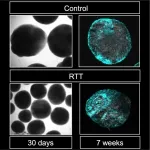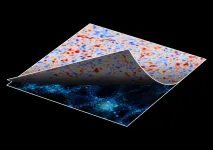Neurobiology: How mice see the world
2021-07-02
(Press-News.org) Researchers based in Munich and Tuebingen have developed an open-source camera system that images natural habitats as they appear to rodents.
During the course of evolution, animals have adapted to the particular demands of their local environments in ways that increased their chances of survival and reproduction. This is also true of diverse aspects of the sensory systems that enable species to perceive their surroundings. In the case of the visual system, these adaptations have shaped features such as the positioning of the eyes and the relative acuity of different regions of the retina.
However, our knowledge of the functional evolution of visual systems in mammals has remained relatively sparse. "In the past 10 or 15 years, the mouse has become the favored model for the investigation of the processing of visual information," says Professor Laura Busse of the Department of Biology II at Ludwig-Maximilians-Universitaet (LMU) in Munich. "That's a somewhat surprising development, given that it was previously thought that these rodents primarily sensed the world using their whisker system and smell." However, color vision in mammals is known to have an effect on the ability to find food, evade predators, and choose mating partners.
"It occurred to us that we don't really know how mice perceive their natural environment visually," says Busse, who is a member of the transregional Collaborative Research Center (CRC) 1233 on "Robust Vision". Here, the term "robust" refers the fact that animals (including humans) are able to draw inferences from limited amounts of visual information, even in environments that are constantly changing. Busse decided to close this gap by studying the visual input and the processing of neuronal signals in mice", In collaboration with Professor Thomas Euler of Tuebingen University, the Coordinating University of the CRC.
A camera that captures the mouse's view
Mice are dichromate - in other words, they have two types of cone cells (the photoreceptors that are responsible for color vision) in their retinas. These cells detect electromagnetic radiation in the green and ultraviolet regions of the spectrum, centered on wavelengths of 510 nanometers (nm) and 350 nm, respectively. "We wanted to know what range of color information is available to mice in their natural habitats, and whether the prevalence of these colors can explain the functional characteristics of the neural circuits in the mouse retina," Busse explains.
Together, the teams in Munich and Tuebingen set out to develop an low-cost, open-source camera which, unlike conventional cameras, was specifically designed to cover the spectral regions in the green and ultraviolet to which the mice retina is sensitive. To facilitate its use in the field, the hand-held camera is equipped with a gimbal, which automatically orients the picture frame, thus avoiding sudden, unintentional shifts in perspective.
The researchers used this camera to image the environment as it would appear to a mouse, at different times of the day, in fields that showed clear signs of their presence. "We knew that the upper hemisphere of the mouse retina, with which they can see the sky, is especially sensitive to UV light," says Busse. "The lower half of the mouse retina, which is normally oriented towards the ground, shows a higher sensitivity in the green region. The team confirmed that these two spectral ranges closely match the color statistics of the natural environments that are favored by mouse populations. This adaptation could be a result of evolutionary processes - and for example help the animal to perceive birds of prey in the sky - and take evasive action. Experiments using artificial neural nets that mimic the processing characteristics of cone cells in the mouse retina confirm this conjecture.
INFORMATION:
ELSE PRESS RELEASES FROM THIS DATE:
2021-07-02
Elisa Cordero, a doctor at the Virgen del Rocío University Hospital, researcher at the Institute of Biomedicine of Seville (IBiS) and professor in the Department of Medicine at the University of Seville, led a study involving researchers from 12 Spanish hospitals to study the clinical characteristics and facilitate the prognosis of solid organ transplant recipients with COVID-19.
The study provides a more precise description of the complications caused by Covid-19 in organ transplant recipients and has provided useful clinical indicators to identify the disease early. This makes it possible to determine therapeutic and care measures ...
2021-07-02
There are plenty of negatives associated with smart technology -- tech neck, texting and driving, blue light rays -- but there is also a positive: the digital age is not making us stupid, says University of Cincinnati social/behavioral expert Anthony Chemero.
"Despite the headlines, there is no scientific evidence that shows that smartphones and digital technology harm our biological cognitive abilities," says the UC professor of philosophy and psychology who recently co-authored a paper stating such in Nature Human Behaviour.
In the paper, Chemero and colleagues at the University of Toronto's Rotman School of ...
2021-07-02
A new study disputes the prevailing hypothesis on why Mercury has a big core relative to its mantle (the layer between a planet's core and crust). For decades, scientists argued that hit-and-run collisions with other bodies during the formation of our solar system blew away much of Mercury's rocky mantle and left the big, dense, metal core inside. But new research reveals that collisions are not to blame--the sun's magnetism is.
William McDonough, a professor of geology at the University of Maryland, and Takashi Yoshizaki from Tohoku University developed a model showing ...
2021-07-02
Ibaraki, Japan - The flavor of a tomato is an interaction between its taste and aroma. Now, researchers from Japan and the United States have revealed that the pigments that determine the colors of tomatoes also affect their flavor.
In a study published this month, researchers from University of Tsukuba developed a new method to rapidly measure the pigment profiles of tomatoes and used the technique to explore how pigments affect the taste and aroma of different tomato varieties.
The color of tomatoes is produced by combinations of different types of pigments, including carotenoids and chlorophylls. These pigments can also affect the accumulation of flavor-related compounds such as sugars, which affect the taste of tomatoes, and volatile ...
2021-07-02
A surprising study by UNSW on the behaviour of unrelated lizards in very different parts of the world has demonstrated how evolution can lead to different species learning the same skills.
The study in Ecology Letters documents how the Anolis lizard species in the Caribbean, and the Draco lizard species in Southeast Asia, have solved the challenge of communicating with one another to defend territories and attract mates.
It found males from both species perform elaborate head bob and push up displays, and rapidly extend and retract their often large and conspicuously coloured dewlap, or ...
2021-07-02
The muskrat, a stocky brown rodent the size of a Chihuahua - with a tail like a mouse, teeth like a beaver and an exceptional ability to bounce back from rapid die-offs - has lived for thousands of years in one of Earth's largest freshwater deltas, in northeastern Alberta, Canada.
Today, this delta lies within one of the largest swaths of protected land in North America: a national park five times the size of Yellowstone that's home to the planet's biggest herd of free-roaming bison and the last natural nesting ground for the endangered whooping crane. It's also central to the culture ...
2021-07-02
Guadalupe fur seals (Arctocephalus townsendi) have established a large resting colony in the Gulf of California--bringing the total number of sites where this endangered species now occurs to just four. This new haul-out was discovered on El Farallón de San Ignacio Island, along the mainland coast of Mexico, according to researchers from Mexico and the University of British Columbia.
Guadalupe fur seals were hunted for their furs and declared extinct in the late 1800's. However, 14 individuals were discovered on Guadalupe Island in 1950--and the population has grown since then. While still designated as vulnerable to extinction, according to IUCN, the population is believed to total 41,000 individuals and is growing ...
2021-07-02
In an Australian world-first, researchers have successfully repurposed two existing medications to reduce the severity of sleep apnoea in people by at least 30 per cent.
Affecting millions around the world, sleep apnoea is a condition where the upper airway from the back of the nose to the throat closes repetitively during sleep, restricting oxygen intake and causing people to wake as often as 100 times or more per hour.
Those with untreated sleep apnoea are more likely to develop cardiovascular disease, dementia and depression, and are two to four times more likely to crash a car than the general population.
Despite almost thirty years of research, there are no approved drug therapies to treat the condition.
Professor Danny Eckert, Principal ...
2021-07-02
Fukuoka, Japan--Medical researchers led by Kyushu University have revealed a possible underlying genetic pathway behind the neurological dysfunction of Rett syndrome. The team found that deficiencies in key genes involved in the pathology triggers neural stem cells to generate less neurons by producing more astrocytes--the brain's maintenance cells.
The researchers hope that the molecular pathology they identified, as reported in the journal Cell Reports, can lead to potential therapeutic targets for Rett syndrome in the future.
Rett syndrome is a progressive neurodevelopmental disorder characterized by impairments in cognition and coordination--with varying severity--and occurs in roughly one in every 10,000 to 15,000 female births. However, it ...
2021-07-02
Japanese astronomers have developed a new artificial intelligence (AI) technique to remove noise in astronomical data due to random variations in galaxy shapes. After extensive training and testing on large mock data created by supercomputer simulations, they then applied this new tool to actual data from Japan's Subaru Telescope and found that the mass distribution derived from using this method is consistent with the currently accepted models of the Universe. This is a powerful new tool for analyzing big data from current and planned astronomy surveys.
Wide area survey data can be used to study the large-scale structure of the Universe through measurements of gravitational lensing patterns. In gravitational lensing, the ...
LAST 30 PRESS RELEASES:
[Press-News.org] Neurobiology: How mice see the world





